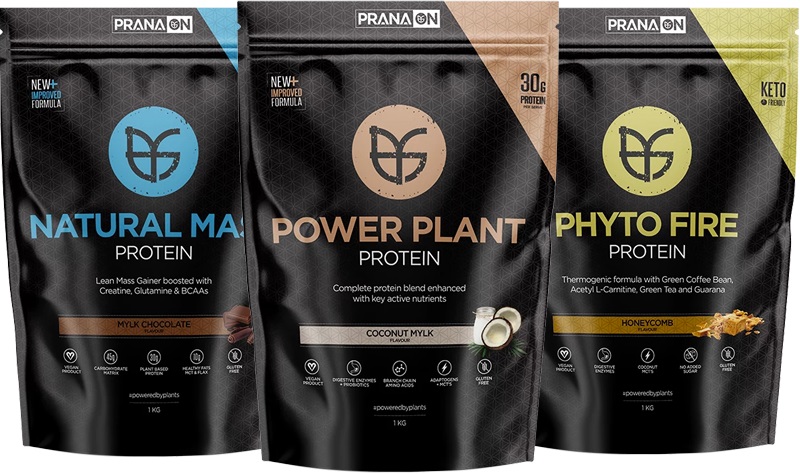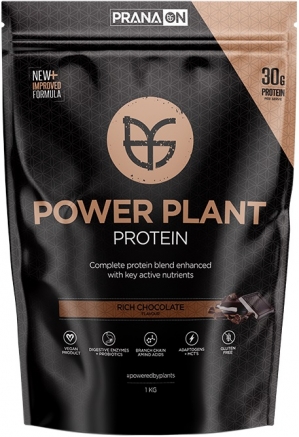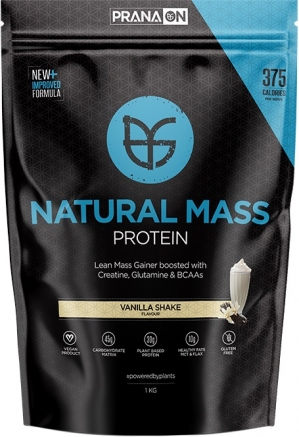Prana Protein Review
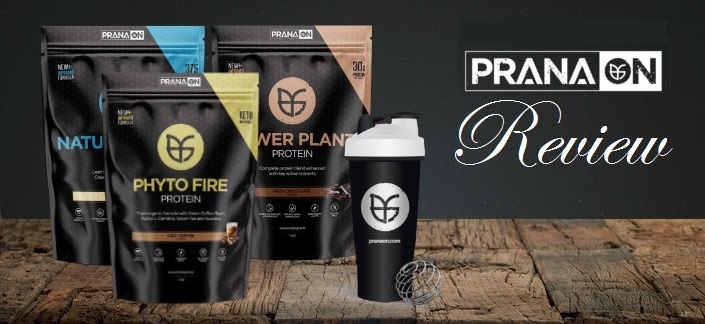
Prana ON are a big deal when it comes to plant-based sports nutrition and wellness supplements. Since their inception, they’ve redefined delicious when it comes to premium vegan protein powder.
Their protein powders tantalise the taste buds and sweep through the mouth like decadently flavoured silk. This can make sticking to the serving size you need, and not the one you want, a decent test of willpower.
Prana have set a standard for plant-based protein flavour and texture that industry competitors are still scrambling to match. And with flavours like Honeycomb, Iced Coffee, Coconut Mylk and Himalayan Salted Caramel, it’s not looking like anyone will get there any time soon.
Prana’s unique range of gluten-free and GMO-free plant-based products includes a natural mass gainer, a lean protein powder, a thermogenic protein, a greens powder and other amino acids and functional formulations.
These products can be used for a range of different reasons, suiting everyday wellness enthusiasts, casual exercisers and professional world-class athletes. And as we are finding out with more confidence each passing year, plants pack more than enough nutritional power to rival their animal-based competitors.
Typically, Prana protein powders contain a blend of vegan proteins, including pea protein, brown rice protein and fababean protein (not in Phytofire), with a peak protein content of 72.5 gram per 100g (Power Plant Protein Original).
Faba Bean (Vicia Faba) is also known as Fava Bean or the Broad Bean. This legume not only contains all nine essential amino acids—as does pea and rice protein— but it is also rich in minerals and is a rare source of L-dopa.
This Prana ON overview will examine Prana Protein Powder, Phyto Fire, Natural Mass and their Greens Powder, with a specific look at some plant-based research and the unique nutritional advantages L-dopa.
Power Plant Protein
Prana’s Power Plant Protein offers the nutritional advantages of pea, rice and fababean protein. For anyone switching from a standard whey protein, this is the way to go.
Though this product doesn’t specifically target mass gains or weight loss, it can still be diligently used for either body composition goal.
Power Plant Protein comes in six enticing flavours, as well as original (slightly sweetened), to ensure your taste buds won’t cry with bored any time soon.
The protein content of each flavour does differ slightly, the lowest of which is 68 grams per 100 gram of powder for Coconut Mylk and Himalayan Salted Caramel, with the highest content at 72.5 per cent for Original.
In terms of protein per serve, they start at 30 grams and go as high as 32.5 grams for Original. These protein variances are normal when it comes to protein powders of any origin, as plain flavours contain less non-protein ingredients. Any ingredient that is not high in protein, like cocoa for instance, dilutes the protein content, reducing the protein percentage.
This is one of the joys of Research and Development. The product needs to taste awesome, but not at the expense of reducing the protein content of the finished product.
Zinc and Iron
Each serve of Power Plant Protein contains a solid 6mg each of iron and zinc. These are two nutrients that can be in shorter supply on a plant-based or vegan diet, making them a welcome inclusion.
The Ministry of Health recommends a daily zinc intake of 8mg for Women (non-pregnant or lactating) and 14mg for men. The recommended daily iron intake ranges from 8-18mg, depending on gender and age. Again, this is for non-pregnant or lactating women. See the links in the references at the bottom of this article for recommendations more specific to your needs.
A single serve of Power Plant Protein contains a significant quantity of zinc and iron, which makes a difference when taken daily over an extended period of time.
It’s worth mentioning, however, as with all “official” nutrient recommendations set as an RDI, these are the basic nutritional requirements for healthy individuals. And even in healthy individuals, these figures may not represent the quantity required for optimal health and chronic disease prevention.
Prana Power Plant Protein contains all nine essential amino acids, in case you’re wondering whether it’s a complete protein or not, with an abundance of naturally occurring branched chain amino acids (BCAAs).

Each serve of Power Plant Protein contains 179-192 calories per serve, which is a little higher than most lean protein powders on the market today. However, the added fats are in the form of Coconut MCT powder, which is great for a number of reasons.
Firstly, the origin of the MCT is disclosed and it is not a palm oil, which, although palm oil crops are highly productive compared to other MCT sources and consume less pesticides, crop expansion and growth has devastated wildlife in Indonesia and Malaysia, leading to massive loss of life of Orangutans in Borneo and Sumatra.
Secondly, medium chain triglycerides (MCTs) are a lot less likely to end up as body fat, and actually offer a range of health benefits. MCTs have been shown to boost satiety, cognition, increase energy expenditure and assist with weight management control (when replacing other dietary fats). Research also indicates that MCTs do not affect metabolic risk factors 1.
Thirdly, given the incredible flavour and texture of these powders, most find the extra energy content more than justified anyway.
The carbohydrate content starts at 4.2 grams per serve and can be as high as 7.4 grams. Though this might seem a lot compared to most lean vegan protein powders, when compared to food sources, 7.4 gram of carbohydrates can be found in just under 1/3 of a medium apple, half a piece of white bread or 1/6th of a cup of cooked rice.
Prana ON Power Plant Protein Nutrition
Comparison Table, per 100g
|
|
Original |
Chocolate |
Vanilla |
Banana |
Coconut |
Caramel |
Strawberry |
|
Energy, kcal |
436 |
406 |
418 |
425 |
427 |
397 |
414 |
|
Kj |
1,830 |
1,700 |
1,750 |
1,780 |
1,790 |
1,660 |
1,730 |
|
Protein (g) |
72.5 |
68.3 |
68.5 |
71.1 |
68.0 |
68.0 |
68.2 |
|
Fat, Total (g) |
10.4 |
7.7 |
7.7 |
8.7 |
9.2 |
8.6 |
7.3 |
|
Carbohydrate, Total (g) |
10.5 |
13.4 |
16.5 |
13.0 |
16.7 |
9.6 |
16.2 |
|
- Sugars (g) |
1.2 |
2.0 |
2.7 |
1.7 |
1.9 |
1.2 |
3.3 |
|
Sodium (mg) |
971 |
962 |
952 |
923 |
917 |
926 |
953 |
The recent re-fomulation of Prana Power Plant Protein has done nothing to diminish the quality of this product. In fact, an argument could be made that it is now better than ever before.
Whether it’s post-workout, between meals or to supplement a low protein meal, this is a vegan product that aims to impress, and succeeds.
Prana ON Phyto Fire Review
When you see the word fire on a bag of protein it’s often accompanied by a picture of a shredded muscular athlete striking a pose with a perfect smile, displaying some hauntingly symmetrical pearly whites.
Or perhaps they’re covered in a sheen of sweat, exuding pure confidence and determination, in the throes of some superhuman weightlifting act or other athletic endeavor.
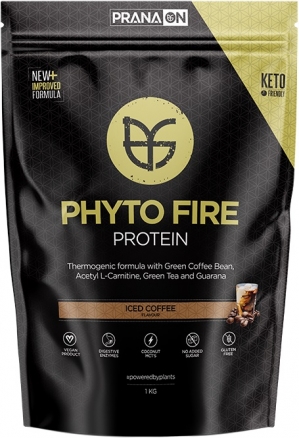 Fortunately, there is no such image on Prana’s Phyto Fire Protein.
Fortunately, there is no such image on Prana’s Phyto Fire Protein.
But the question remains, why are words like fire and heat associated with fat-burning products in the first place? And do these concepts become problematic in summer, when the heat of the season can be overbearing at the best of times?
Even if you follow a ketogenic diet, occasionally going bananas is not uncommon when exposed to an unrelenting mixture of Australian heat and humidity, without air-conditioning.
The human body is a masterful creator of heat. So much so, that scientists are starting to wonder how this heat can be converted to energy, to power wearable electronic devices.
But that’s a complete digression from the topic at hand.
The human body creates more heat when protein is consumed instead of carbohydrates or fat. This is believed to be caused by an increase in protein synthesis, which is an energy demanding process.
And when the mitochondria increase their activity level to provide more energy in the form of ATP, for things like repairing muscle tissue, more heat is created as a result.
There are also plenty of natural herbs and nutrients that can increase the metabolic rate and the amount of calories we burn at rest (and during activity). Most of these effects are attributed to sympathetic nervous system activation.
When the sympathetic nervous system is more active, the peripheral blood vessels are constricted and body heat is conserved. Food intake tends to decrease and resting energy expenditure increases as well. And with each ATP molecule hydrolysed, even more mitochondrial heat is created 2,3.
In fact, it’s believed that around 60% of energy released by the hydrolysis of ATP is lost as heat, rather than to provide energy for the required reaction 4.
So it’s fair to say that many nutrients used during weight loss or body fat maintenance programs, like protein, caffeine and EGCG, will increase body heat, hence terms like fire and heat are used in associations with fat-burning.
Prana Phyto Fire Protein contains Matcha Green Tea and Green Coffee Bean, both of which have been shown to support thermogenesis. This effect is triggered to a greater degree than would be expected from their caffeine content alone.

EGCG is a polyphenol antioxidant found in Green Tea that has demonstrated increased energy expenditure and brown fat cell thermogenesis, amongst many other benefits 5.
Recent research findings indicate that chlorogenic acid enriched coffee increases fat loss of the abdomen and viscera, decreasing waist circumference and BMI, compared to other groups studied 6.
In addition, Phyto Fire Protein contains Guarana, Inositol, Choline and Acetyl L-Carnitine, to support fat loss, as well as Coconut-derived MCT powder to enhance energy and focus.
At around 158 calories per serve, the addition of Phyto Fire to standard weight loss programs or bodyfat maintenance won’t bloat your daily calorie intake. This makes it easy to keep your protein intake up, which is important for maintaining lean body mass when engaging in a negative-energy balance to lose weight.
Prana Mass Gainer Review
Back in the day, when Prana first released this natural mass gainer, it was a relief to the many health conscious consumers who had to resort to experimenting with powders in their own kitchen in order to create something healthy or using a standard mass gainer product.
Finally, a mass gainer that wasn’t based on maltodextrin, glucose (dextrose) and even fructose was available, the primary ingredient of which is tapioca starch, derived from cassava root.
Though tapioca starch doesn’t contain the full nutritional profile of cassava root, which was previously used in Prana Natural Mass, it is certainly a step up from the refined and high-glycemic index ingredients typically used in mass gainers.
And though an argument could be made for the use of fructose powder in mass gainers as a low glycemic index option, there are a range of other health concerns associated with the overconsumption of this dietary sugar.
The reason for the inclusion of tapioca starch in this formula becomes apparent when actually mixing and consuming the finished product. Tapioca starch creates a much smoother drink with enhanced palatability compared to Cassava root.
The protein in this product is primarily pea and rice based, with a small amount of fababean protein added, somewhere around the 4.5% mark. Without going into too much detail on the benefits of pea and rice protein, these are certainly high quality proteins, offering close to or as much nutritional benefit as whey protein isolate.
Two clinical trials have indicated that pea protein is as effective as whey protein at promoting muscle thickness. In fact, pea protein actually out-performed the whey protein by (a non-statistically-significant) 4.6% 7!
The second study highlighted the ability of pea protein to match whey protein in a group of 15 men and women undergoing high intensity functional training. No differences were noted between groups for body composition, muscle thickness, force production, strength and 1RM for the deadlift and squat 8.
And though it is still early days when it comes to practical research examining these topics, this is certainly promising and should alleviate any fears relating to stopping whey protein or animal-based protein powders.

Pea protein actually offers a separate set of benefits that whey doesn’t, such as soluble fibre, antioxidant phenolic compounds, folate and minerals, such as selenium, potassium and magnesium 9,10.
And then there’s rice protein … which surely won’t offer much help in building a couple of bulging traps or triceps that bust out of your T-shirt and say hello to all passers-by, will it?
If that’s what you’re into, that is.
In 2013, Nutrients published a research paper that showed after 8 weeks of either whey or rice protein post-workout supplementation, there was no difference between groups when it comes to body composition and performance 11.
On top of this quality protein and carbohydrate blend, forming the basis of Prana Natural Mass Gainer, there is also flaxseed powder, providing the Omega 3 Linolenic acid, Coconut MCTs, Creatine, Glutamine and BCAAs.
Though it’s beyond the scope of this review article to go into the benefits of these nutrients for health, let’s just say that they’re all holistically-health-appropriate and helpful for gaining size, strength and power.
Prana Greens Review
Prana Greens has been popular since its release many years ago. Apart from the fact that the Fresh Mint Flavour can be a nice holiday for your palate if you’re switching from another brand—and yes, it does taste that good—this product is loaded with plenty of nutrition to assist in keeping you alkalized and energized.
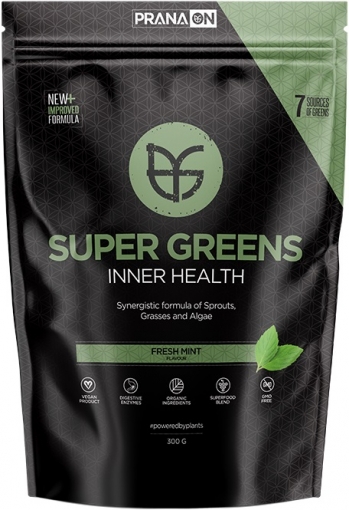 It goes without saying that greens powder can never replace a quality plant-based or vegan diet. There are many hundreds, if not thousands, of natural compounds found in foods that a handful of ingredients, even as awesome as Matcha green tea, broccoli and chlorella, can never match.
It goes without saying that greens powder can never replace a quality plant-based or vegan diet. There are many hundreds, if not thousands, of natural compounds found in foods that a handful of ingredients, even as awesome as Matcha green tea, broccoli and chlorella, can never match.
Fussy eaters often apply the it’s-better-than-nothing rule to greens powders, which is certainly true. However, taking a greens powder isn’t a reasonable qualification for consuming less fresh fruit and vegetables and not making an effort with the general quality of your diet.
Though it’s a subtle distinction, it’s an important one.
Greens Powders are better viewed as dietary adjuncts. These products help bridge the gap between fresh produce that is of a high quality, and what most of us consume.
For instance, high quality plant-based foods are grown with optimal soil fertility and mineral content, ideally with organic and even biodynamic farming practices. However, most plants are grown in the conventional fast-as-possible method, involving pesticides, herbicides and basic minerals only to trigger high yields, like potassium.
In addition, given the rapid pace of modern lifestyles, the mental and emotional toll they can take and the prevalence of chronic degenerative disease, nutrient demands are high.
This makes greens products a great idea to keep your nutrient intake topped up.
Prana Greens provides a range of nutrient rich ingredients, such as chlorella (rich in chlorophyll) and Broccoli, offering indol-3-carbinol, sulforaphanes and more. Alfalfa Grass contributes greatly to the overall alkaline power of this product.
What is Prana Protein Powder Sweetened With?
Prana use the natural sweeteners Monk Fruit Extract and Steviol Glycosides (a Stevia extract). Given that all other ingredients are naturally derived, this makes them all-natural products.
 Monk fruit, also known as Luo Han Guo, is a plant native to Southern China and Northern Thailand. This natural sweetener has been used in natural products worldwide for decades.
Monk fruit, also known as Luo Han Guo, is a plant native to Southern China and Northern Thailand. This natural sweetener has been used in natural products worldwide for decades.
Food Source L-Dopa
Favabean, the Broadbean and Fababean (Vicia faba) are all interchangeable terms for the same legume, which is one the best dietary sources of L-Dopa. Mucuna pruriens or Velvet Bean is another excellent source 12.
L-Dopa is an amino acid precursor to dopamine, and is capable of passing through the blood brain barrier, unlike dopamine. The dopamine pathway starts with phenylalanine, which is converted to tyrosine, then onto L-dopa and dopamine, with the help of the nutrient cofactors iron, vitamin C and folate.
Dopamine has immediate effects in the brain, but can also be further converted to noradrenaline and adrenaline. Dopamine is a neurotransmitter with may improve mood, motivation, attention, working memory and learning 13.
Final Thoughts
Setting aside the environmental and ethical benefits of vegan products, you can be sure that your body will have the nutritional support it needs, even if you’re switching from long-term whey protein use.
If you’re recently going vegan or increasing your plant-based food intake, you need not scale down your performance expectations or elongate your recovery considerations, as research is indicating that the power of the plant is great indeed.
In present times, research continues and the sharing of information via the internet has hastened our understanding of what plants actually have to offer. Many celebrities and world-class athletes are revealing their personal adherence to and support for this eating plan.
Twenty years ago, the word vegan or vegetarian was associated with the mental image of a thin, pale person, barely able to hold their own against a stiff breeze. Now we know that the muscle-bound strongman (or strongwoman) out-lifting everyone without breaking a sweat might just be following a long-term vegan or plant-based diet.
Article by Gavin Deguara, ND, Grad Cert Nutr Med
References
- St-Onge M-P et al. Medium Chain Triglyceride Oil Consumption as Part of a Weight Loss Diet Does Not Lead to an Adverse Metabolic Profile When Compared to Olive Oil. The Journal of the American College of Nutrition. 2008 Vol 27;5 p.547-552.
- Guarino D et al. The Role of the Autonomic Nervous System in the Pathophysiology of Obesity. Frontiers in Physiology. 2017.
- Messina G et al. Autonomic Nervous System in the Control of Energy Balance and Body Weight: Personal Contributions. Neurology Research International. 2013
- Berne & Levy physiology. Berne, Robert M., 1918-2001., Koeppen, Bruce M., Stanton, Bruce A. (6th, updated ed.). Philadelphia, PA: Mosby/Elsevier. 2010.
- Dulloo A.G. et al. Efficacy of a green tea extract rich in catechin polyphenols and caffeine in increasing 24-h energy expenditure and fat oxidation in humans. American Journal of Clinical Nutrition 1999 Vol 70 p.1040-1045.
- Watanabe T et al. Coffee Abundant in Chlorogenic Acids Reduces Abdominal Fat in Overweight Adults: A Randomized, Double-Blind, Controlled Trial. Nutrients 2019 Vol 11;7
- Babault N et al. Pea proteins oral supplementation promotes muscle thickness gains during resistance training: a double-blind, randomized, Placebo-controlled clinical trial vs. Whey protein. Journal of the International Society of Sports Nutrition, 2015 Vol 12;3
- Banaszek A et al. The Effects of Whey vs. Pea Protein on Physical Adaptations Following 8-Weeks of High-Intensity Functional Training (HIFT): A Pilot Study. Sports (Basel) 2019 Vol 7;1 p.12
- Dahl W et al. Review of the health benefits of peas (Pisum sativum L.). The British Journal of Nutrition. 2012 Vol 108 S3-S10
- Krefting J. The Appeal of Pea Protein. Journal of Renal Nutrition 2017 Vol 27;5 p.e31-e33
- Joy J.M., et al. The effects of 8 weeks of whey or rice protein supplementation on body composition and exercise performance. Nutrition Journal. 2013 Vol 12; 86
- Polanowska K et al. Development of a Sustainable, Simple, and Robust Method for Efficient L-DOPA Extraction. Molecules 2019
- Olguin HJ et al. The Role of Dopamine and Its Dysfunction as a Consequence of Oxidative Stress. Oxidative Medicine and Cellular Longevity 2016
Header Image Background Designed by Derich, Courtesy of FreePik



